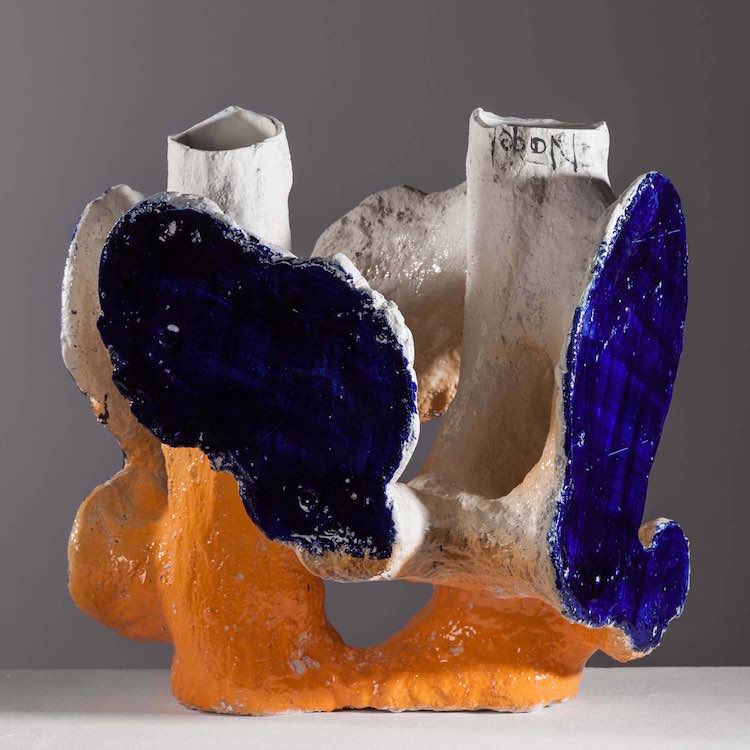SOLOTHURN, Switzerland—Ever since Johannes Nagel began working with ceramic materials, which is now almost fifteen years, his main interest has been dedicated to the central object of his profession: the vessel. That is but the continuous attempt to reinterpret an ancient cultural technology in contemporary terms. The fact that he employs seemingly archaic means is not in any way inconsistent to either himself or to the viewer.
Featured image: Johannes Nagel, Orange blue 2017, Porcelain, 50 x 40 x 61 cm
For the production of his forms Nagel uses a sand casting technology he developed himself. The procedure is reminiscent of the spouting of cavities archeologists do when they want to render dissolved organic artifacts visible. Nagel begins his work with excavations in sand. For this he only uses his hands. He creates cavities that cannot be examined by sight. Yet control is still possible. The digging is not an act of spontaneous improvisation but is implicated in an idea of the desired outcome, including some measure of divergence and surprise. This practice is a prime example of the complex interrelationships of hand and brain that we all know from first-hand experience. Immanuel Kant described the hand as “the visible part of the brain.” In his Anthropological Didactic he writes:
“The sense of touch lies in the fingertips and their nerves (papillae) in order to discover by touching the outside of a solid body its peculiar form.”
The forms dug by Johannes Nagel owe their shape to his groping hands.
The cavity is his matrix into which he pours the porcelain slip. The sand drains the viscous porcelain mass of its water. In all slip casting methods the superfluous material has to be poured out once the desired wall thickness has been attained. During the ensuing shaping the casting form is necessarily lost—thus precluding repetition. The procedure of digging and shaping recalls an alchemist’s laboratory. If we are thinking here of Tschirnhaus and Böttger, who, by trial and error, uncovered the secret of the “white gold” and produced the first European hard porcelain, the comparison is not so far-fetched. However, Johannes Nagel’s sculptures with their porous, crazed and rough skin have little in common with the smooth surfaces of conventional porcelain vessels. They remind Ilka Rambausek of “primeval shapes from the history of their own species.”
All works by Johannes Nagel are answers to his programmatic question: “What is the function of vessels today, what could be their content?” He is not concerned with manufacturing usable vessels. Rather, vessel as a topos, like a rhetorical device, is the central point of reference of his work, while its result is more than just the citation of the shape of a utensil.
“In their observation the more or less clearly recognizable vase shapes are compared to a vague recall of the evolution of forms. Their efficacy, then, lies in the difference or the shift. The same is true in principle of the more abstract forms,” says Johannes Nagel.
These ceramics fall within a spectrum between a functional form that might just about still be usable and an art object that has been liberated of all practical functions, yet they carry the traces of their manufacture like a signature label. Johannes Nagel delights in arranging his ob-jects into smaller or larger tableaux. Here, the elective affinity of his forms becomes clearly visible.
Extracted from a text written by Renate Luckner-Bien, published in Art Aurea April 2017
Current Exhibition:
Träge Spuren (Traces of Wear)
Kunstforum Solothurn Gallery
December 9, 2017 – February 3, 2018
Related Reads:
http://cfileonline.wpengine.com/art-vessel-experiments-german-artist-johannes-nagel/
Do you love or loathe these vessel forms from the world of contemporary ceramic art and contemporary ceramics? Let us know in the comments below.







Add your valued opinion to this post.